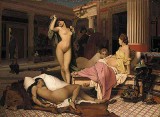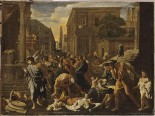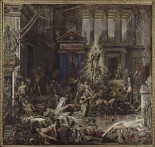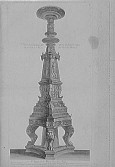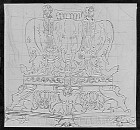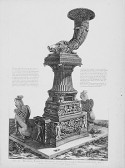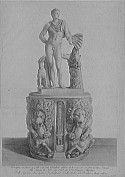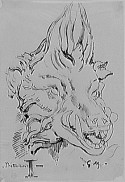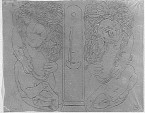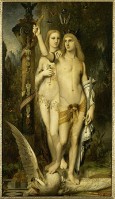The browser will either open the file, download it, or display a dialog.
Recent scholarship, particularly the work of Peter Cooke, has done much to draw attention to Gustave Moreau's ambitions as a history painter in the French academic tradition, thereby challenging received notions of his position as an isolated precursor of Symbolism.[1] Heir to various idealist philosophical traditions, and also clearly anticipating later Symbolist ideology, Moreau persistently condemned his modern era as materialist and positivist. One of the clearest artistic symptoms of this positivism for Moreau was the cultivation of archeological accuracy in popular modes of historical genre painting, evident in the painstakingly researched and rendered décors, furnishings, props and costumes of works like Ingres's Antiochus and Stratonice or the subsequent néo-grec paintings of Jean-Léon Gérôme (figs. 1–2). Against the supposed claims of such work to historical authenticity, Moreau formulated a principle of "archeological allegory," which entailed the use of archeological source material in highly eccentric, deliberately anachronistic ways in his compositions. As I will elaborate here, he conceived of this strategy as part of his broader efforts to reassert the rights of poetry and imagination in art and thereby reinvigorate the French tradition of history painting, which many mid-nineteenth-century commentators felt to be moribund. In the process, however, he redefined history painting as a private, subjective dream space that disrupted its traditional identity as an eminently public genre emphasizing discursive clarity and narrative legibility.
The historical accuracy claimed by the genre archéologique, as practiced by the likes of Gérôme, had to some extent always been an important criterion for academic history painting. It followed from overarching principles of decorum or convenance, whereby the accessories of a composition were to be truthful and appropriate to the main subject and its time and place, and the pursuit of historical exactitude was certainly one way the artist could demonstrate his learning.[2]
By the mid-nineteenth century, however, the ever-more-rapid pace of archeological discovery was putting history painters in an untenable situation, as they were being held to increasingly pedantic standards of historical exactitude. "No anachronism escapes us, and we pardon nobody on this score," Charles Lenormant wrote in connection to Ingres's Antiochus and Stratonice (fig. 1), summarizing the new spirit.[3] For many critics, archeology offered a promising direction for modern history painting in the cultivation of "local color," a way to render it more scientifically objective and to separate it from the poetic generalities that once passed in the genre. For the more culturally conservative, however, the advent of the genre archéologique and the "mania of erudition"[4] driving it threatened the sacrosanct values and priorities of serious history painting. Materialist notions of historical truth, manifest in the archeological bric-à-brac cluttering contemporary painting, undermined the dramatic, moral, and intellectual heart of grande peinture. Historical genre painters following in the train of Ingres and Delaroche were routinely charged with cultivating accessories to the detriment of their principal, human subjects; with lavishing attention on the description of contingent, external facts rather than distilling from their subjects eternal, general truths. The judicious selectivity that once regulated the tableau's internal economy had supposedly yielded to an uncritical profusion of minutiae. Most broadly, the increasing focus on material accessories was symptomatic of genre painting's threatening encroachment on the field of history painting.[5] Ultimately, many critics felt, conspicuous displays of archeological erudition were no substitute for what they perceived as a lack of elevated intellectual or poetic conception. In the worst cases, like Gérôme's notorious brothel scene, A Greek Interior (fig. 2), such displays only served to highlight the comparative poverty and vulgarity of the artist's imagination.[6]
Even those sympathetic to painters' archeological research acknowledged the losses painting incurred in the tradeoff between poetry and erudition. As Lenormant mused:
Where is the time when Raphael could put a violin bow in the hand of Apollo? Painters back then drew from … ancient monuments a general inspiration more sympathetic than reasoned. Nowadays every man who wants to treat an antique subject will have to pass through the arid paths of erudition. Once the painter read the poets; today, he will have to translate the scholiasts.[7]
Gustave Moreau's father, Louis, encapsulated the contemporary ambivalence toward archeology when he counseled his son in 1857:
I am not at all for a painter submitting his composition to a meticulous archeology, which becomes ridiculous. M. Ingres proved that all too much in his Stratonice …; but one should not, out of disdain for such archeology, put the barbaric architecture of Louis XV in paintings representing antique subjects. The difficult thing is to arrive at local color without creating a feeling of scientific pretension, which is always harmful to the composition.[8]
Somehow one had to avoid archeological pedantry while staying true to historical context.
The harshest attacks against archeologizing trends came from proponents of the painting of modern life. In the opening pages of The New Painting (La Nouvelle Peinture, 1876), for example, Edmond Duranty pointed out the rapidly changing state of archeological knowledge, and warned the so-called archéologues that today's rigorous exactitude would be tomorrow's risible anachronism. It would be best, he consequently argued, that art ground itself in the immediate present rather than pursue a chimerical past.[9]
Moreau's art and theory were strongly conditioned by such criticisms and debates. Rather than reject archeological minutiae in a futile attempt to recapture the lost grandeur of painting past, he set out to recuperate the allegedly degraded means of contemporary art by investing them with a new aura of poetry. This meant willfully redirecting to non-historicizing ends the archeological details furnished by modern scholarship, which contemporary history painters apparently ignored at some peril. Moreau subjected these details to a logic other than that of conventional decorum, to what he called the "sublime logic of pure imagination."[10] As he presented his approach, Moreau came to his sources not with the ponderous erudition of the archeologist (an erudition some scholars are intent on claiming for him[11]), but with the ludic sparkle of a child: "much more given to the dreams and phantasmagorias of the imagination … I bring to each reading, to each account of the customs of disappeared or distant civilizations a naivety, a child's credulity."[12]
In practical terms, this imaginative approach meant deliberate anachronism. The equation of anachronism with imagination was an easy one to make. As Lenormant's above-cited comments about Raphael make clear, anachronisms in old master painting were viewed nostalgically by those who felt that painting's poetry had been compromised by modern scholarship. Moreau was similarly regretful. Anachronisms in work like Nicolas Poussin's were, for him, not symptomatic of the imperfect state of historical knowledge in previous centuries but a sign of poetic freedom. If Poussin supplied the Academy with the very model of the humanist artist-scholar in pursuit of historical truthfulness or vraisemblance,[13] Moreau recast him along romantic lines, quite anachronistically, as a genius unbound by such strictures:
Having to represent a very ancient and primitive people, of a famous and proud city, according to the poets, delivered to the horrors of famine and plague, how could Poussin (Raphael or whoever else) have been able to do so if they didn't have recourse to what I will call archeological allegory. How… could they have expressed the idea of richness, of grandeur, of nobility in their architecture? It is only by having recourse to anachronism. Through an incredible fortune enjoyed only by genius, they found the means of blending together, and for the greatest imaginative satisfaction, the most opposed and extreme civilizations. [Consider the] example of [Poussin's] plague of the Philistines. I have always been struck … by the little apparent logic in the works of the masters and immortal geniuses. In choosing Poussin … as an example, I had my reasons…It is because he is the painter par excellence of reason and good sense…despite all, he is always carried away by the power of imagination. If one wants to study his oeuvre well, one will see that, despite his desire to be true, exact, logical, rational, etc., etc., he can never resist these fecund and sovereign transports that push him towards this sublime logic of pure imagination, so distant from the logic of good sense and reason.[14]
Moreau makes it clear that Poussin's challenge in The Plague of Ashdod (fig. 3) had been to evoke a remote civilization for which there was little surviving documentation. This gap in the historical record, however, opened up space for license, for the capriciously eclectic engineering of his painting's décor. As Moreau's comments imply, "archeological allegory" did not just mean an archeology subservient to a specific poetic idea (here, the idea of "richness, of grandeur, of nobility") but, more crucially, an archeology subservient to the irrational dictates of the imagination.
Correspondingly, Moreau tended to favor legendary subjects of a "fabulous antiquity" that provided greater room for fanciful re-imaginings than less remote, and more documented, historical subjects. In the process, he availed himself of an eclectic array of archeological and antiquarian sources, freely combining and juxtaposing motifs for suggestive effect.
Paradigmatic is one of his most ambitious compositions, The Suitors, which he conceived in the early 1850s and developed and expanded over the next four decades (fig. 4).[15] It was in his private written commentaries for this picture that Moreau first articulated his notion of "archeological allegory."[16]Moreau's subject derives from Homer's Odyssey and represents Odysseus, having finally returned to his palace in Ithaca, slaying the parasitical suitors of his wife Penelope. As was typical for him, Moreau gave an allegorical gloss to the story. With Poussin's painting in mind, he envisaged The Suitors as a quasi-Biblical scene of divine chastisement,[17] in which Athena—under whose aegis Odysseus triumphs—represents spiritual and moral force, and the suitors—typed by Moreau as barbaric, oriental, and effeminate—represent a decadent, materialist civilization.[18] This allegorical reading clearly mirrors Moreau's portrayal of himself as a combative defender of spiritual values in a decadent, materialist society.[19]
According to one of his notes, Moreau intended the décor, at least at some point in the painting's development, to reinforce the notions of triumphant virtue and nobility that he associated with Hellenic civilization. Instead of recreating an architectural setting evocative of archaic, pre-Homeric times, as historical convenance would require, he sought to evoke the heights of Attic civilization, the "time of Pericles … the most noble time in Greece," with "a tempered architecture pure in style."[20] Among the painting's rich architectural and decorative details are certainly many authentically Grecian motifs that Moreau could easily have found in publications in his library, from pioneering archeological studies like Stuart and Revett's The Antiquities of Athens to contemporary sourcebooks on ornament like Owen Jones's The Grammar of Ornament.[21] Rather than stylistically unified or "pure," however, the result is extremely heterogeneous, evoking in its wide range of reference a more generalized Greco-Roman antiquity. Foregoing the Attic Doric of the Periclean Parthenon, for instance, Moreau introduces the Ionic and Corinthian orders and by superimposing them conjures Roman rather than Greek architecture. More generally, in its grandiose, operatic scale, ornamental extravagance, and deliriously additive composition, Moreau's part-palace, part-prison setting resonates much less with the noble Greek ideal he initially indicated and much more with opposing ideas of cultural decadence. The attendant associations of oriental splendor, luxury, and barbarism evidently gave the artist even freer reign to his imagination.[22]
In the license evident in The Suitors, Moreau may be seen as a neo-romantic heir to the architectural fantasies of recent forebears like John Martin or Piranesi, as Cooke has suggested.[23] Piranesi in particular was a tutelary spirit for Moreau, for he stood on principle for an imaginative approach to (Roman) antiquity that went against the grain of neoclassical orthodoxy, and for an inventive archeology that admitted of fantasy and showcased the excessive, ornate, bizarre, monstrous, and fragmentary.[24] The foreground of Moreau's painting—a crazy, orgiastic pile-up of bodies, luxury objects, and the leavings of an extravagant feast—is literally strewn with souvenirs of Piranesi, which Moreau lifted from his copy of the late eighteenth-century compendium, Vases, Candelabras, Grave Stones, Sarcophagi, Tripods, Lamps and Antique Ornaments (Vasi, candelabri, cippi, sarcofagi, tripodi, lucerne ed ornamenti antichi,1778).[25] To cite only a few among many examples, a print illustrating a candelabrum from a Roman villa near Tivoli furnished Moreau with the elephant-head motif featured in the center foreground of the painting (figs. 5–6), while a print describing an antique tomb monument from the Via Appia outside Rome provided him with the boar's head that he interjected into the lower right foreground (figs. 7–8). Another boar's head, in the bottom left corner of the painting, derives from a print of an ancient statue, while the motif of rampant lions attacking deer from the elaborate pedestal in the same print crops up at the right edge of Moreau's painting (figs. 9–11).
Such isolating, excerpting, and transposing of motifs was typical of Moreau's practice. As scholars have amply documented, Moreau fed voraciously off his personal library and archive, a veritable musée imaginaire that comprised an extensive array of artworks, reproductions, photographs, illustrated books, catalogues, and journals—all of which are still preserved in the Musée Gustave Moreau.[26]His stockpile was, to cite the titles of two of his favorite periodicals, a Magasin pittoresque, a store of imagery, or a Tour du monde, a tour of the world that substituted for actual travel. In the virtual space of this archive, temporal and cultural boundaries were readily effaced, leaving the artist—and bourgeois armchair voyager—free to combine elements in any manner he saw fit.
Such combinations may well be touted as a sign of Moreau's imaginative liberty, in keeping with his own self-portrayal, but what sort of historical attitude informed such freedom? What did it mean to approach the past as a magasin pittoresque, or store of images to be plundered?
A common claim of archeological genre painting was its ability to "resurrect" the past. Novelists like Théophile Gautier played upon such conceits in works like The Mummy (La Roman de la momie, 1858), in which a modern-day encounter with a miraculously-preserved mummy provides the framing device for an imaginative resuscitation of ancient Egyptian society in the main body of the text, which is filled with descriptive word-picturesthat evidently set out to rival the productions of contemporary historical genre painting.
Moreau recognized the historical fallacy involved in the general project of archeological résurrectionisme. In his Notice on M. Gustave Boulanger (Notice sur M. Gustave Boulanger), delivered on the occasion of his ascension to the late Boulanger's seat in the Academy in 1890, Moreau argued that no matter how close one's attention to archeological detail was, one inevitably ignored the profound "difference of civilizations, in what touches on moral habits and the heart of customs."[27] The spirit of remote civilizations remained "always mysterious and misunderstood" to the modern Frenchman who was bound by "the intellectual civilization of his race."[28] Moreau evidently felt that Boulanger's popular genre paintings, despite being set in Greco-Roman antiquity, betrayed an inescapably modern (and trivializing) sensibility. Adhering to what he described as an "archeology of sentiment, of imagination" rather than to an archeology of accurate material accessories, Moreau insisted that "only poetic sentiment [can] give a new life" to remote epochs.[29]
But what sort of "new life" did that past enjoy in his art? A strong sense of historical ruin seems to have informed Moreau's anachronistic reordering of fragmentary archeological motifs. Death lay at the core of his historical imagination, and it was through death that the past was yielded up for allegorical re-inscription in his art. Repeatedly he drew attention, often sympathetically, to the barbaric, decadent, fallen, or sacrificed—those destroyed, conquered, or superseded in the march of history—whether the orientalized suitors slaughtered by Odysseus; the Persian commander Darius brought low in his flight from the forces of Alexander the Great (MGM, cat. 223); the Thracian king Diomedes executed by Hercules (Rouen, Musée des Beaux-Arts); or the pagan poets succumbing before the ascendant spiritual principle of Christianity in The Dead Lyres (MGM, cat. 106). Moreau was not just interested in remote epochs, but in the epochal transitions between civilizations, between east and west, pagan and Christian. This was where the drama of the world historical epic lay. Moreau presented these transitions in his writings in the triumphal terms of Spirit's progressive victory over Matter,[30] but his paintings themselves are more ambivalent, hinting at a darker vision of history as a continual process of violent sacrifice, an expiatory ritual of death yielding an innumerable crop of corpses. It is no coincidence that Moreau's chief example of "archeological allegory" was Poussin's Plague at Ashdod, its subject being one of collective death: the Biblical chastisement of the Philistines.
This darker vision of history, I suggest, strongly informed Moreau's conception of "archeological allegory." Resonant here is Walter Benjamin's discussion of allegory in The Origin of German Tragic Drama (Der Ursprung des deutschen Trauerspiels, 1928).[31] Very crudely summarized, Benjamin argues that at the heart of allegory is a preoccupation with death and the passage of time, a sense of radical estrangement from the past and tradition, a sense of the draining of significance away from objects and of meaningful experience from life. The allegorist views history catastrophically, in melancholy terms of silencing, dissolution, and decay—the ruin becoming the quintessential allegorical emblem.[32] Consequently, the allegorist perceives the world as a jumble of fragments to be deciphered, and proceeds by appropriating his imagery from the totality of its former context and reinterpreting it, rather than restoring some original meaning that had been obscured or lost. In the process, however, he denies the image its own claims to significance. Inherent in such an operation for Benjamin was an attitude of melancholy:
If the object becomes allegorical under the gaze of melancholy, if melancholy causes life to flow out of it and it remains dead, but eternally secure, then it is exposed to the allegorist, it is unconditionally in his power. That is to say it is now quite incapable of emanating any meaning or significance of its own; such significance as it has, it acquires from the allegorist. He places it within it, and stands behind it; not in a psychological but in an ontological sense.[33]
The melancholic's pleasure in allegory is to enslave his imagery in an "eccentric embrace of meaning," to create a hermetic world in which significance would rule "like a stern sultan in the harem of objects."[34] As Benjamin notes, citing Benedetto Croce, this subjecting of "'the real world of objects and events'" to an "'ideal world of causes and meanings'"[35] could be sadistically cruel, for it may command the destruction of organic bodies so that meaning could be made from the remains. In the baroque dramas he discusses, death and especially martyrdom were ways of preparing the body for emblematic purposes; "characters … die, because it is only thus, as corpses, that they can enter into the homeland of allegory."[36] One is reminded of the extravagant orgy of death in The Suitors and the righteous allegorical reading of spiritual triumph that Moreau projects onto it.
The allegorical work for Benjamin is inorganic and makes no attempt to mask the artificiality of its arrangement. The allegorist proceeds in piecemeal fashion by taking fragments as the material of creation and obsessively piling them up.[37] Accumulative in composition, the allegorical work betrays a slackness of arrangement, a sense of artificial "collectedness" rather than organic unity. Benjamin compares the allegorical work to the disordered character of magicians' dens or alchemists' labs—also common descriptors, incidentally, of Moreau's studio.[38]
In light of this description, one which could also apply to Moreau's accretive working procedures, "archeological allegory" was more than the expression of a desire to reclaim the sovereign rights of the imagination in history painting. It was also the expression of a yearning to connect to some legendary past and a fatalistic avowal of the impossibility of doing so, an acknowledgment of the divide between the poetic plenitude of the past and an alienated present.
However lofty Moreau's conception of himself as an allegorizing artist-poet, many of his early critics dismissed him as a mere accumulator of bric-à-brac. Criticism was harshest in 1865, when he exhibited Jason at the Salon (fig. 12). Moreau was charged with abusing detail by encumbering his composition with "curiosities,"[39] "knick-knacks,"[40] "bibelots,"[41] or "pretty symbolic nothings."[42] Critics pointed in particular to the column Moreau had garnished with a concatenation of ornaments, wrapped in a banderole, and topped with a ram's head and statuette of a sphinx; the winged and orbed caduceus behind Jason; and the multicolored birds swarming about. As Félix Deriège snidely commented, the painting seemed to include "an entire taxidermist's and bric-à-brac merchant's shop."[43] Léon Lagrange rhetorically asked Moreau: "would the [picture of] Jason … hide a symbol? Would it be the apotheosis of the collector? In effect we've got medals, little bronzes, enamels, arms, birds, fabrics. You might as well see it through in that case: don't leave out the postage stamps."[44]
By comparing Moreau to a collector or dealer of bric-à-brac, critics were identifying him with the contemporary bourgeois culture of material consumption and accumulation that Edmond de Goncourt famously diagnosed as "bricabracomania."[45] However much Moreau may have resisted such an association, the modern type of the bourgeois collector, as theorized by Remy Saisselin and others, does help illuminate his conception of "archeological allegory."
As Saisselin has argued, the democratization of collecting in the nineteenth century, manifest in the widespread enthusiasm for bibelots, was inseparable from the emergence and consolidation of the bourgeois private sphere and the increasing importance for the modern subject of an intimate, interior space insulated from the harsh realities of the modern, urban world.[46] "Bricabracomania," Edmond de Goncourt noted in the introduction to The House of an Artist (La Maison d'un artiste, 1881), was a solitary pleasure, a regressive escape into a realm of private esthetic experience that was indicative of a general social malaise.[47] In Saisselin's account, the modern collector is much like Benjamin's allegorist, approaching the past like a petrified landscape, a "gigantic quarry of bibelots."[48] Collector and allegorist alike are struck by the same spectacle of ruin, by the scattered confusion in which the things of the world are found, and this spectacle gives rise to a psychology of accumulation.[49] Just as the allegorist appropriates his fragmentary images, the collector severs his objects from their origins, divests them of their function or use-value, and confers upon them a more intangible "fancier's value," as Ackbar Abbas has argued.[50] The collector decontextualizes his objects and reinscribes them in the transcendent, ahistorical context of the collection, reframing them as he wishes. As Susan Stewart has emphasized, the collection is premised on an act of forgetting, its point being to "[start] again in such a way that a finite number of elements create, by virtue of their combination, an infinite reverie."[51]
The private collection consequently replaces a historical narrative with a narrative of the individual collector. Collecting becomes a matter of self-projection and self-fashioning. Because the collected object is divested of its original function or significance, any value it has is relative to the collector alone. As a microcosm of the self, the world of the bibelot became for the nineteenth-century bourgeois a world of private reverie. "Here…he gathered objects," Saisselin writes, "from remote places and the past to create the space of his dreams and secret longings; here, too, his psyche betrayed itself through the objects he gathered."[52] Or in Jean Baudrillard's words, the private collection creates a "space where the everyday prose of the object-world modulates into poetry, to institute an unconscious and triumphant discourse."[53]
With regard to the archeological accessories and details in Moreau's paintings, it indeed becomes difficult to distinguish between the procedures of inventing and collecting. Within his hôtel-cum-atelier, the space of artistic creation was directly contiguous with the domestic spaces of the bourgeois interior. His archival fund of imagery and his collection of objets d’art together offered him endless material for escapist reverie. And like the eclectic collection, Moreau's paintings open up a free space, relatively unfixed in its historical and cultural coordinates, by decontextualizing and rearranging motifs according to an inscrutable personal logic, creating the impression that his works must be born of some deep interiority. Indeed, Moreau's obsessive amassing of ornaments within the traditionally public space of history painting is one of the clearest signs of his privatization of the genre.
One major consequence of the kind of modern subjectivity Moreau brought to history painting—a subjectivity which I have described with reference to Benjamin's allegorist and Saisselin's bric-à-brac collector—was the crisis of the classical tableau as a unified ensemble. I will conclude by examining Moreau's self-description as an "assembler of dreams (assembleur de rêves)," a phrase frequently cited but rarely scrutinized.[54]
It is a highly ambivalent pairing of words. By the nineteenth century, words like "assembler," "assemblage," or "combinaison" had acquired opposing connotations. In academic discourse, these were positive or neutral terms that described the work of composition.[55] Invention consisted of the "assemblage of thoughts"[56] or "combination of ideas."[57] One "assembled" or "combined" the parts of a picture synthetically in the composition of a whole.[58] A proper assemblage signaled the transformative combination of elements derived from reality, and combination was what distinguished imaginative creation from the merely mimetic transcription.[59] The implication was that there was an intelligent, ordering principle at work. At the same time, however, "assemblage" and "combination" had also come to indicate the false, uninspired, and conventional. Moreau's romantic generation spoke of "cold academic combinations"[60] that lacked a desired sense of spontaneity, sincerity, and naturalness. Patiently to "assemble" or "combine" the elements of one's tableau also could mean that one painted mechanically or formulaically, more like a professional craftsman than an inspired artist.[61] To the enthusiastic genius belonged the magical ensemble, to the cold practitioner the ineffectual assemblage. "Assemblage" implied a work that fell short of real unity, that failed to attain the synthesis of its individual parts. For romantics, artists like David and Ingres, rather than manifesting the impetuous burst of a creative imagination in a spontaneously, imperiously unified composition, built up their inert works piecemeal through carefully studied parts. Alphonse Rabbe, for example, accused David of treating painting as a pedestrian, mechanical mustering of academic studies and the debris of the classical past: "His paintings are like solemn convocations in which all the fragments of antiquity appear, bas-reliefs, statues, vases, medals…"[62]
For Moreau to call himself an "assembler," then, was at once to identify his art with traditional procedures of invention and, perversely, to implicate his practice in degraded compositional techniques. "Dreams," of course, is the critical qualifier. First, it lends romantic luster to the deficient "assemblage," investing it with an aura of poetry. Second, it substitutes for the more determinate "idea" of the academic composition more romantically indeterminate notions of the dream.
Above all, assembling dreams meant assembling details, each of which offered the viewer a potentially all-consuming point of reverie. Moreau's writings are revealing here. While he does pay some lip service to composition as a structured whole, terms like "unity" and "ensemble" come up with remarkable infrequency. When he does speak of the picture as a unity, his terms are weak: a painting's surface is "more or less unified, more or less capricious."[63] When he speaks of the "master idea" governing the details of a composition, it is not to advocate the judicious selection of details to promote the scene's legibility; rather, he simply asserts that this "master idea" would persist despite a profusion of details. Moreau found an idiosyncratic model for richness and complication in Mozart, whom he praises for presenting "each piece of his work like a jewel mounted with gold and precious stones":
The subject finds itself in the midst of this medley of marvelous details, because it is not possible for it not to dominate the ensemble for the very reason that the master idea is the strongest. It is true that for vulgar minds, this is no longer painting. They do not know where to begin before such manifestations of genius.[64]
This "genius," Moreau believed, lay in the perfection of the painting down to the smallest details. When he speaks of the compositional ensemble, it is only to emphasize how a single element may be made to stand out from it: "Relief of the ensemble – Relief of the morceau. Field on which the principal motif relies."[65] The "field" is considered a surface against which individual elements distinguish themselves; like the setting of a jewel, its job is to offset those details, "to make [them] shine."[66] While this principle of accentuation is geared towards the privileging of principal over secondary parts, the logic at work is implicitly a disruptive one: the detail asserts itself against and at the expense of the compositional field. More than any putative ensemble, such insurgent details had the power to attract and transfix the gaze and unchain the imagination. From this perspective, a monumentalizing Michelangelo and a miniaturizing Cellini were equally worthy of emulation, "both [artists being] equally passionate for the morceau of execution from which they make a world of ideas gush forth."[67] To borrow Roland Barthes's term, the detail for Moreau could thus function as a disruptive "punctum" in the tableau and become a point of intense, imaginative investment.[68]
Moreau described this investment most clearly in relation to single human figures who were detached from the main action in works like The Suitors. For him, they provided the viewer with focal points of contemplative absorption:
This figure [the poet in the center of the composition] takes no apparent part in the drama that surrounds him. What does this body signify … this indifference for all that surrounds him…? I respond first … that the ancients often had in their most dramatic compositions some of these calm figures serving as a repose for the mind and the eyes…It seems to me that these figures recall the spectator to purely plastic beauty…These morceaux, tyrannical in their air of inopportunity, draw the eyes and attention undividedly and force the spirit to prefer the contemplative immobility of the human body to its action and movement. Thus a moment of repose for the spirit, [a] greater disposition to meditate and dream and recall more elevated and mysterious thoughts, superior to the action itself…These figures at first disconcert, then attract …, [and] soon charm and lead you on … towards the dream and the abstract. I will always prefer these [figures] in any composition.[69]
I submit that Moreau's penchant for archeological detail was partially motivated by a similar, "purely plastic" attraction. Rather than accord the viewer a position of mastery over a dramatic and visual unity or ensemble, as academic theory would typically have it, Moreau singled out the detail for its ability to distract, subjugate, and ultimately liberate the viewer. The privileged morceau becomes an anti-compositional force that disrupts the dramatic priorities and rhetorical conventions of history painting, reducing a work's main action to background noise. It is in the ruins of history painting, in the scattered debris that Moreau so meticulously and prominently installed in apocalyptic visions like The Suitors, that he and his viewers, as individual, private, and inescapably modern subjects, found a new aesthetic freedom, however marginal.
I would like to acknowledge Dr. Carol Armstrong, whose constructive criticism was invaluable in the writing and editing of my dissertation, "Gustave Moreau (1826–1898) and the Afterlife of French History Painting," (Princeton University, 2007), from which the present argument derives, and also Dr. Nina Athanassoglou-Kallmyer, whose 2009 CAA conference panel, "The Classical Unconscious," helped bring this article into focus. Translations are my own unless otherwise indicated. The abbreviation "MGM," used throughout the text, notes, and illustration captions, refers to the Musée Gustave Moreau in Paris.
[1] On Gustave Moreau's ambitions and strategies as a history painter, see Peter Cooke's Gustave Moreau et les arts jumeaux: Peinture et littérature au dix-neuvième siècle (New York: Peter Lang, 2003) and "Gustave Moreau and the Reinvention of History Painting," Art Bulletin 90, no. 3 (September 2008): 394–416; and Scott Allan, Gustave Moreau (1826–1898) and the Afterlife of French History Painting (Ann Arbor: UMI, 2007). For a lucid historiographic overview of Moreau scholarship as well as suggestions for future work, particularly on Moreau's relationship to later nineteenth-century Symbolism and Decadence, see Peter Cooke, "Symbolism, Decadence and Gustave Moreau," Burlington Magazine 151, no. 1274 (May 2009): 312–18.
[2] In their dictionary entry for "accessory," for example, 18th-century academic theorists Claude-Henri Watelet and P. Ch. Lévesque summarized these basic ideas of convenance: "Les accessoires doivent être choisis dans les circonstances du temps et du lieu, relatives à l'action qu'on représente. La théorie de l'Art impose la loi d'employer les accessoires les plus propres à caractériser le sujet qu'on traite, à le faire bien connoître, à indiquer le moment qu'on a choisi, le lieu qu'on représente, et à contribuer par-là au plus grand avantage de la composition poétique, par les moyens qu'offre la composition pittoresque. Les accessoires enfin doivent servir à étendre, à multiplier les idées relatives au sujet du tableau; mais ce doit être surtout sans distraire de l'affection principale, que l'Artiste a dessein d'inspirer." Dictionnaire des arts de peinture, sculpture et gravure, 5 vols.(Paris: L. F. Prault, 1792), 1:12.
[3] "Aucun anachronisme ne nous échappe, et nous n'en passons à personne." Charles Lenormant, "La Stratonice de M. Ingres," in Beaux-Arts et Voyages (Paris: M. Lévy, 1861), 360.
[4] Ibid., 361.
[5] For good discussions of the erosion of the boundaries between history painting and genre painting over the course of the nineteenth century, a phenomenon for which the encroachment in historical works of painstakingly rendered material accessories in the name of "local color" was taken to be symptomatic, see Marie-Claude Chaudonneret, "Du 'genre anecdotique' au 'genre historique': Une autre peinture d'histoire," in Les Années romantiques: La peinture française de 1815 à 1850, exh. cat. (Paris: Réunion des Musées Nationaux, 1995), 76–85; and Paul Duro, "Giving up on History? Challenges to the Hierarchy of the Genres in Early Nineteenth-Century France," Art History 28, no. 5 (Nov. 2005): 689–711.
[6] Albert de la Fizelière, for example, criticized Gérôme on dual grounds: for an archeologizing, archaizing style that confused "la lettre morte [of antiquity] avec l'esprit vivifiant," an error he shared with the néo-grec school more generally (described as "ces petits Etrusques invétérés"); and for the "misère" and "honte" of his painting's conception. Citing public morals, the critic complained: "C'est pousser loin l'oubli du respect de soi-même que d'exhiber au Salon, avec la garantie de l'Etat, une toile dont la reproduction gravée serait poursuivie par la police…" Exposition national: Salon de 1850–1851 (Paris, 1851), 61–62.
[7] "Où est le temps où Raphaël pouvait impunément mettre un archet dans la main d'Apollon? Les peintres puisaient alors dans l'aspect des monuments antiques une inspiration générale et plus sympathique que raisonné. Tout homme qui désormais voudra traiter un sujet de l'antiquité devra passer par les voies arides de l'érudition. Autrefois, le peintre lisait les poètes; aujourd'hui, il lui faudra traduire les scoliastes." Lenormant, "La Stratonice de M. Ingres," 360–61.
[8] "Je ne suis nullement pour qu'un peintre soumettre sa composition à une archéologie minutieuse qui devient ridicule. M. Ingres l'a trop prouvé dans sa Stratonice et d[ans] son Anthiocus [sic]; mais il ne faut pas, en haine de cette archéologie, mettre l'architecture barbare de Louis XV dans des tableaux représentant des sujets antiques. Le difficile c'est d'atteindre la couleur locale sans que l'on sente une prétention de science qui nuit toujours à la composition." Letter from Louis to Gustave Moreau, Nov. 27, 1857, in Luisa Capodieci, ed., Gustave Moreau: Correspondance d'Italie (Paris: Somogy Editions d'Art, 2002), 95.
[9] As Edmond Duranty wrote: "Croient-ils que parce qu'il auront exécuté les casques, les tabourets, les colonnes polychromes, les barques, les bordures de robes, d'après les derniers décrets rendus par l'archéologie; croient-ils que parce qu'ils auront scrupuleusement essayé de respecter, dans leurs personnages, le type le plus récemment admis de la race ionienne, dorienne ou phrygienne; croient-ils enfin que parce qu'ils auront terrassé, pourchassé, envoyé au diable le monstre Anachronisme, ils auront fait grande œuvre d’art. Ils ignorent que tous les trente ans, la susdite archéologie fait peau neuve, et que la calotte béotienne à nasal et à couvre-joues, par exemple, qui est le dernier mot de la mode érudite, ira rejoindre à la ferraille le grand casque du Léonidas de David, qui fut dans son temps l'extrême expression du savoir es-choses antiques. Ils ignorent que c'est au feu de la vie contemporaine que les grands artistes, les esprits sagaces éclairent ces choses antiques." La Nouvelle peinture: A propos du groupe d’artistes qui expose dans les galeries Durand-Ruel (Paris: E. Dentu, 1876), 5–6.
[10] Gustave Moreau, Ecrits sur l'art, ed. Peter Cooke, 2 vols. (Fontfroide: Bibliothèque Artistique et Littéraire, 2002), 1:51.
[11] The assumption of Moreau's archeological erudition informs, for instance, the patiently researched and highly detailed litany of archeological and historical sources in Marie-Laure de Contenson's "Réminiscences romanes dans l'œuvre de Gustave Moreau," Revue d'Auvergne 553, no. 4 (1999): 231–50.
[12] "Je suis d'autant plus propre aux rêves, aux fantasmagories de l'imagination, que j'apporte à toute lecture, à tout récit des usages des civilisations disparues ou lointaines, une naïveté, une crédulité primesautière d'enfant." Moreau, Ecrits 1:161.
[13] Moreau would have come across ample evidence within Poussin's own correspondence regarding his concern for historical vraisemblance. As Poussin wrote to his patron Paul Fréart de Chantelou from Rome on November 25, 1658 in connection to his painting of the Holy Family in Egypt: "Je vous ai promis de vous donner le détail des objets qui sont au fond du dernier tableau que je vous ai fait; le voici: On y voit une sorte de procession de Prêtres Egyptiens, qui ont la tête rasée, et sont … vêtus selon l'usage du pays. Les uns ont des timbales des flûtes, des trompettes; les autres portent des bâtons a tête d'épervier. Il y en a qui sont sous un porche, et qui s'acheminent vers le temple de leur Dieu Sérapis, portant le coffre dans lequel étoient enfermés ses os. Derrière une femme vêtue de jaune, est une sorte de fabrique faite pour la retraite de l'oiseau Ibis, que l'on y voit représenté, et une tour dont le toit est concave, avec un grand vase pour recueillir la rosée. Ce spectacle n'est point un caprice de l'imagination: tout cela est tiré de ce fameux temple de la Fortune, à Palestrine, dont le pavé, composé d'une très-belle mosaïque, représente, au vrai et de bonne main, l'histoire naturelle et morale de l'Egypte et de l'Ethiope. J'ai mis dans mon tableau toutes ces choses, d'abord pour délecter par leur nouveauté et variété, puis pour montrer que la Vierge, qui y est représenté, était alors en Egypte." Collection de lettres de Nicolas Poussin (Paris: Firmin Didot, 1824), 337–38 (my emphasis). Moreau had a copy of this volume in his library (MGM, inv. 13879). For a discussion of Poussin's "archeological" approach to antiquity in connection to this letter, see Charles G. Dempsey, "Poussin and Egypt," Art Bulletin 45, no. 2 (June 1963), 109–19.
[14] "Poussin (Raphaël ou tout autre) eussent-ils a
[15] For a thorough discussion of the genesis, sources, and subject of this painting, see Peter Cooke, "History Painting as Apocalypse and Poetry: Gustave Moreau's Les Prétendants 1852–1897, with Unpublished Documents," Gazette des beaux-arts, 6th ser., vol. 127, no. 1524 (Jan. 1996): 27–47.
[16] Moreau, Ecrits 1:48–59.
[17] Moreau described, for example, the suitors as "figures de jugement dernier fuyant devant la foudre divine." Ibid., 48.
[18] As Moreau wrote: "Voilà bien tous ces princes, orientaux efféminés, Grecs abâtardis ou matériels, pleins de force brutale ou de langueur, fuyant comme un vil troupeau devant Minerve, la sagesse immuable, la morale éternelle." Ibid., 52.
[19] See Cooke, "History Painting as Apocalypse and Poetry," 36. For a more extensive discussion of Moreau's combative, spiritualist stance and its allegorical projection into many of his most iconic pictures, see Allan, Afterlife of French History Painting, 107–63.
[20] "J'ai choisi pour fond à cette scène une architecture tempérée d'un style pur…cette architecture du temps de Périclès qui rappelle en Grèce le temps de la plus grande noblesse et du goût le plus pur." Moreau, Ecrits 1:49.
[21] Moreau had French editions of both publications in his library: Les antiquités d'Athènes, mésurées et dessinées par J. Stuart et N. Revett, 4 vols. (Paris: Firmin Didot, 1808–22)(MGM, not yet inventoried), and Owen Jones, Grammaire de l'ornement (London: B. Quaritch; Paris: Chez tous les Libraires, 1865)(MGM, inv. 14806). A number of instances of Moreau's borrowing from Jones have been documented; see, for instance, Luisa Capodieci, "Gli ornamenti simbolici: L'Uso degli elementi decorative nella Salomè tatuata di Gustave Moreau," Richerche di Storia dell'Arte 57 (1995): 9, 20n28.
[22] On Moreau's free-wheeling eclecticism in connection to his orientalist work, particularly his notorious Salome Dancing Before Herod (Hammer Museum, Los Angeles), see Peter Cooke, "Gustave Moreau's Orient, or 'la civilization Moréene,'" in Eastern Voyages, Western Visions: French Writing and Painting of the Orient, ed. Margaret Topping (New York: Peter Lang, 2004), 213–39.
[23] Cooke first suggested such comparisons, though he did not discuss Moreau's actual borrowings from Piranesi in this work. See "History Painting as Apocalypse and Poetry," 41, 47n73.
[24] See Allan, Afterlife of French History Painting, 266–68.
[25] Moreau's collection of Piranesi prints from this publication can be found in the Musée Gustave Moreau, Paris, inv. 11919.
[26] For a useful introduction to Moreau's use of such sources, see Geneviève Lacambre, "Documentation et création: L'exemple de Gustave Moreau," in Usages de l'image au XIXe siècle, ed. Stéphane Michaud, Jean-Yves Mollier, and Nicole Savy (Paris: Editions Créaphis, 1992), 79–91.
[27] "Boulanger n'a pas tenu tout à fait assez compte de la différence des civilisations, en ce qui touche les habitudes morales comme aussi le fond des mœurs. "Moreau, Ecrits 2:344.
[28] "une âme, un esprit, un tempérament occidental étant forcément rivés à la psychologie, à la civilisation intellectuelle de sa race, et ne pouvant s'exprimer sûrement, complètement qu'à cette condition de rester dans le milieu pour lequel ils ont été créés." Ibid., 343.
[29] "il paraîtrait assez simple et assez naturel … que des époques historiques, devenues presque légendaires par l'éloignement des temps, ne puissent être traduites qu'à la condition que le sentiment poétique seul les reconstitue et leur donne une vie nouvelle. / Cette archéologie de sentiment, d'imagination, était celle de Rembrandt, très peu conforme à la tradition." Ibid., 344.
[30] To cite but one example, Moreau mused thus on his openly allegorical composition, The Dead Lyres, in 1897: "Mais la grand lyre de l'âme, la grande voix aux cordes vibrantes de l'idéal vraiment divin vient éteindre, abolir toutes ces voix des sens, ces voix de la matière glorifiée." Ecrits 1:154.
[31] See Walter Benjamin, The Origin of German Tragic Drama, trans. John Osborne (London: New Left Books, 1977), 159ff. My necessarily brief characterization of Benjamin's argument is particularly indebted to Craig Owens, "The Allegorical Impulse: Toward a Theory of Postmodernism," in Art after Modernism: Rethinking Representation, ed. Brian Wallis (New York: The New Museum of Contemporary Art, 1984), 202–6. See also Erika Fischer-Lichte, "Walter Benjamin's 'Allegory,'" American Journal of Semiotics 4 (1986): 151–68.
[32] Benjamin, German Tragic Drama, 178.
[33] Ibid., 183–84.
[34] Ibid., 202, 184.
[35] Ibid., 193.
[36] Ibid., 217.
[37] Ibid., 178.
[38] Ibid., 188. As Paul Leprieur similarly described Moreau's studio: "Pour lui c'est un laboratoire, et il s'y livre loin du bruit à son travail d'alchimiste toujours inquiet, amoureux de perfection et qui cherche à faire de l'or." "Gustave Moreau," L'Artiste, 8th ser., 58 (March 1889): 164.
[39] Charles Clément, for instance, described the painting as "…une foule de curiosités, de petites et très intelligentes combinaisons de détail ; des bibelots plus soignés que les parties capitales de l'ouvrage, exécutés avec une verve extraordinaire de pinceau et une précision à effrayer M. Blaise Desgoffe, mais que, pour ma part, je trouve déplacés dans un tableau d'histoire." "Exposition de 1865," Journal des débats, May 10, 1865.
[40] Félix Deriège wrote, for example: "Moreau serait bien embarrassé de nous dire ce que signifient son Jason et sa Médée, debout et immobiles l'un derrière l'autre, et la colonne à tête de bélier qu'ils ont à coté d'eux, et la foule de bimbeloteries qui les entourent." "Beaux-Arts. Salon de 1865," Le Siècle, June 18, 1865.
[41] Léon Lagrange wrote, for example: "quel rapport entre les bibelots de M. Moreau et le sujet qu'il représente?" "Le Salon de 1865," Le Correspondant, n.s., 29 (May 1865): 141.
[42] As P. Challemel-Lacour wrote: "Cet entassement d'oiseaux bleus, d'armes brisées, de colonnettes votives, de jolis riens symboliques … tout cela est l'amusement d'une fantaisie éprise de la science un peu puérile des peintres du XVe siècle." "Le Salon de 1865," Revue moderne 34, no. 1 (July 1, 1865): 97.
[43] "tout une boutique s'empailleur et de marchand de bric-à-brac." Deriège, "Salon de 1865."
[44] "Le Jason cacherait-il aussi un symbole? Serait-ce l'apothéose du collectionneur? En effet, voici des médailles, des petits bronzes, des émaux, des armes, des oiseaux, des étoffes: dans ce cas, allez jusqu'au bout, n'oubliez pas les timbres-poste." Lagrange, "Salon de 1865," 142.
[45] Edmond de Goncourt, La Maison d'un Artiste, 2 vols. (1881; Dijon: L'Echelle de Jacob, 2003), 1:3, (citation to the 2003 reprint).
[46] Rémy G. Saisselin, The Bourgeois and the Bibelot (New Brunswick: Rutgers University Press, 1984), 29.
[47] See de Goncourt, La Maison d'un Artiste, 1:3.
[48] Saisselin, Bourgeois and the Bibelot, 73.
[49] As Saisselin writes, "the bourgeois collection was not necessarily a gallery or collection geared to some historical view of the development of art or the visual expression of some guiding esthetic or historical principle. It might be thus among some amateurs or historians; but as expressive of the general tendency of the times, it tended to bric-a-brac, clutter, accumulation." Ibid., 65.
[50] Ackbar Abbas, "Walter Benjamin's Collector: The Fate of Modern Experience." New Literary History 20, no. 1 (Autumn 1988): 219–20.
[51] Susan Stewart, On Longing: Narratives of the Miniature, the Gigantic, the Souvenir, the Collection (Baltimore and London: Johns Hopkins University Press, 1984), 152.
[52] Saisselin, Bourgeois and the Bibelot, 29.
[53] Jean Baudrillard, "The System of Collecting," in The Cultures of Collecting, ed. John Elsner and Roger Cardinal (London: Reaktion Books, 1994), 8.
[54] See, for instance, Jérôme Godeau's lyrical evocation of Moreau as visionary at work in his studio in the short essay "L'Assembleur de rêves," in Gustave Moreau: Mythes et chimères, exh. cat. (Paris: Musée de la Vie Romantique, 2003), 19–24. The phrase comes from Moreau's self-description as an "ouvrier assembleur de rêves." See L'assembleur de rêves: Ecrits complets de Gustave Moreau, ed. Pierre Mathieu (Fontfroide: Fata Morgana, 1984), 96.
[55] Paillot de Montabert, for example, wrote: "[l'artiste] cherche; il trouve; il combine ou compose; et, pour parvenir, il procède à la disposition de l'ensemble et des parties de son œuvre." L'Artistaire, livre des principales initiations aux beaux-arts (Paris: A. Johanneau, 1855), 176.
[56] Michel-François Dandré-Bardon wrote in his 18th-century treatise, for example: "L'invention est l'assemblage des pensées qui concourent à la composition d'un sujet; c'est le choix des objets qui doivent y entrer." Traité de peinture (1765; repr., Geneva: Minkoff, 1972), 80,(citation to the 1972 reprint).
[57] Ernest Chesneau, for instance, used this phrase as a term of praise in connection to Moreau, in "Exposition universelle, Beaux-Arts, Les Inédits de l'école française, I. MM. Meissonier et Gustave Moreau," Le Moniteur universel, October 9, 1878.
[58] Henri Testelin described compositional ordonnance as "l'assemblage et la disposition de toutes les parties de la peinture." Les Conférences de l'Académie royale de peinture et de sculpture au XVIIe siècle, ed. Alain Mérot(Paris: Ecole Nationale Supérieure des Beaux-Arts, 1996), 341. Some two hundred years later, Charles Blanc's language was not much different, when he describes composition embracing "l'invention du peintre et l'économie de son tableau, à tel point qu'on l'emploie souvent comme un synonyme du tableau lui-même. Dans son acception plus restreinte, la composition n'est autre chose que l'ordonnance, c'est-à-dire l'art de mettre en ordre les éléments du tableau, de les disposer, de les combiner." Grammaire des arts du dessin (1867; Paris: Ecole Nationale Supérieure des Beaux-Arts, 2000), 473.
[59] As Ernest Chesneau distinguished Delacroix from many of his contemporaries: "Ils nous communiquent d'intéressants témoignages sur ce qu'ils ont vu, mais strictement sur les êtres, les faits et les choses qui se sont réfléchies effectivement dans la chambre noire de leur organe visuel. Ils sont incapables d'imaginer, je veux dire de combiner, de coordonner des réalités vues, incapables d'assembler les éléments fournis par le spectacle du monde, et d'en composer un spectacle infiniment plus élevé et plus émouvant, celui des passions, des sentiments, des sérénités, des tristesses, des haines, des adorations, de tout ce qui constitue la vie dans l'humanité." Peintres et statuaires romantiques (Paris: Charavay Frères, 1880), 204.
[60] "froides combinaisons académiques." Léon Lagrange, "Le Salon de 1864," Gazette des beaux-arts 16, no. 6 (June 1, 1864): 515.
[61] A contemporary definition for "assemblage" reads, for instance: "Assemblage—Mode de jonction des pièces de charpente et du bois de menuiserie. Il y a différentes manières d'assembler; on assemble à clef, en crémaillère, à onglet, par montaise, etc., mais l'étude de ces différents modes d'assemblage fait partie du domaine de la construction bien plus que de celui de l'art." Jules Adeline, Lexique des termes d’art, new ed. (Paris: A. Quantin, 1884), 33.
[62] "Ses tableaux sont comme des convocations solennelles où apparaissent tous les fragments de l'antiquité, bas-reliefs, statues, vases, médailles." Alphonse Rabbe, Biographie universelle et portative des contemporains, ou dictionnaire historique des hommes vivants et des hommes morts depuis 1788 jusqu'à nos jour….5 vols. (Paris: F. G. Levrault, 1834), 2:1222.
[63] "le champ en peinture. Cette surface plus ou moins unie, plus ou moins capricieuse, sur laquelle se détache une forme quelconque." Moreau, Ecrits 2:254.
[64] "Cette nécessité où se trouve le musicien de présenter chaque morceau de son œuvre comme un joyau serti d'or et de pierreries. Ce charme pour l'ouvrier de présenter le plus grand intérêt sous le plus petit volume…. Voilà les maîtres primitifs italiens, voilà les grands maîtres de la belle époque musicale…. Le sujet se trouve au milieu de tout ce mélange de merveilles de détails, parce qu'il n'est pas possible qu'il ne domine pas l'ensemble par cela même que l'idée mère est la plus forte. Il est vrai que pour les intelligences vulgaires, il n'y a plus de peinture. Elles ne savent où se prendre devant de pareilles manifestations du génie." Ibid., 248.
[65] "Relief de l'ensemble – Relief du morceau. / Des champs sur lesquels s'appuie le motif principal". Ibid., 246.
[66] "Je prends pour exemple une main, un bras, etc… d'une figure principale qu'il s'agit de mettre en lumière et de nettement faire ressortir et exprimer sur un fond de figures, casques, lances, et c'est donc le fond que j'appelle le champ. Des moyens que le sentiment, le goût, la science enseignent pour arriver à faire briller cette forme." Ibid., 254.
[67] "Tous deux également passionnés pour le morceau d'exécution et en faisant jaillir un monde d'idées." Ibid., 250.
[68] As Barthes describes the punctum: "it is this element which rises from the scene, shoots out of it like an arrow, and pierces me. A Latin word exists to designate this wound, this prick, this mark made by a pointed instrument: the word suits me all the better in that it also refers to the notion of punctuation, and because the photographs I am speaking of are in effect punctuated, sometimes even speckled with these sensitive points; precisely, these marks, these wounds are so many points." Camera Lucida: Reflections on Photography, trans. Richard Howard (New York: Hill and Wang, 1981), 26–27.
[69] "Cette figure ne prend aucune part apparente au drame qui l'entoure. Que signifie ce corps … cette indifférence pour tout ce qui l'entoure …? Je réponds d'abord, en m'appuyant sur des exemples et sur des traditions qui peuvent être comprises et … me servir de rempart, que les anciens avaient souvent dans leurs compositions les plus dramatiques de ces figures calmes servant de repos a l'esprit et au yeux...Il me semble que ces figures rappellent le spectateur à la beauté purement plastique…. Ces morceaux, tyranniques par leur air d'inopportunité, appellent les yeux et l'attention sans partage, et forcent l'esprit à préférer l'immobilité contemplative du corps humain à l'action et au mouvement de ce corps. Donc temps de repos pour l'esprit, disposition plus grande à méditer et à songer et à se reporter vers des pensées plus élevées et plus mystérieuses, supérieures au fait lui-même...Ces figures déroutent d'abord, puis attirent de préférence, charment bientôt et vous entraînent où j'ai déjà dit, vers le songe et l'abstrait. Ce sont celles que je préférerai toujours dans toute composition." Moreau, Ecrits 1:53–54. For further discussion of this key passage, see Cooke, "History Painting as Apocalypse and Poetry," 38–40.



